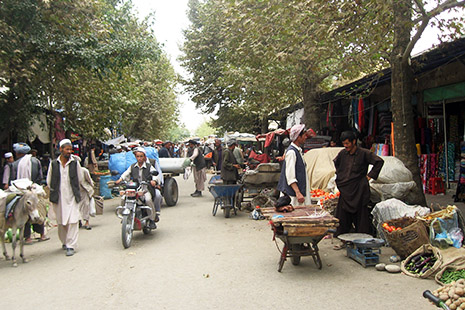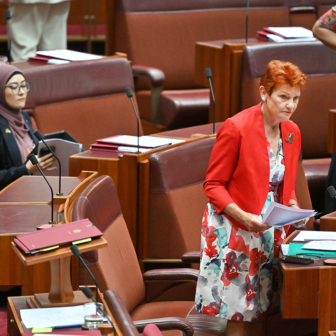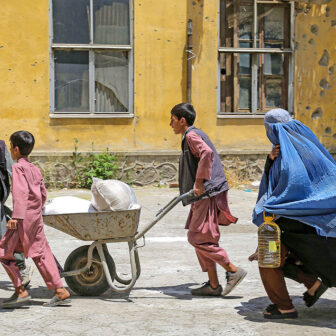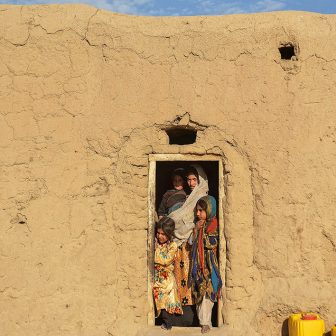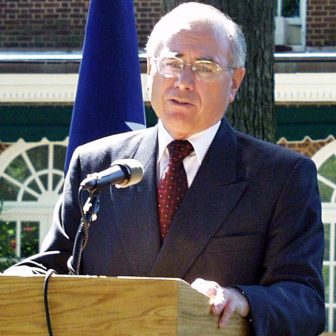TEN years ago, a conference in the German city of Bonn agreed on a roadmap – the Bonn Agreement – for the creation of a post-Taliban administration in Afghanistan. Taliban were excluded from participation and subsequent Afghan governments were strongly dominated by Taliban’s former foes. Ten years later, Taliban were once again absent at this week’s second Bonn conference, which was boycotted by Pakistan in protest against an American air strike inside Pakistan that killed twenty-four Pakistani soldiers. All the main speakers emphasised the need for peacemaking with the Taliban.
The reality is that the war in Afghanistan is unwinnable. Yet many people in the West still believe that killing Taliban fighters keeps up military pressure that might eventually lead to a negotiated outcome. For their own reasons, the Taliban also see military pressure as sound strategy. Both sides are probably wrong. The escalated military contest is likely to be as unwinnable as the war.
The side that reaches this conclusion first and declares a temporary ceasefire – a ceasefire that becomes permanent if the other side reciprocates – will have a considerable advantage. Not only would it be good strategy for the United States or the Taliban to make the first move, it would also be smart for Pakistan to change course and advocate such a move, regardless of who moves first.
Despair grows in Afghanistan. Obama’s surge increased the killing and capture of Taliban, but killings by the Taliban have surged even more steeply. The 2011 fighting season is the worst the war has seen, especially for civilians. Meanwhile, the government of Afghanistan enjoys less legitimacy than ever and is edging towards becoming a narco-state. Opium production is expected to rise further in 2012 to supply more than 90 per cent of the world’s illicit trade.
It is hard to be sure whether President Hamid Karzai’s administration is sincere in its statements supporting a genuine reconciliation with the Taliban leadership. What is clear is that many around the president and in the Afghanistan High Peace Council want to sabotage reconciliation. They want to hold onto the benefits that flow into their corrupt pockets from the war economy, lucrative contracts, foreign aid and the drug trade. They fear they might lose their positions in a power-sharing deal with the Taliban, whether that deal gives the Taliban some ministries in Kabul or a degree of autonomy in certain regions.
The first-mover advantage
So there is little hope that the Afghan government will be bold enough to initiate a unilateral ceasefire. The Taliban has a stronger interest in surprising the West by being the first mover, and President Obama is also capable of making a genuinely decisive peace gesture. Polls indicate that a large majority of ordinary Afghans support a peace deal in which the Taliban share power but do not dominate. And because so many reconciliation conversations are occurring within Afghan civil society, some influential Afghans, within and outside cabinet, might swing behind reconciliation if Obama or the Taliban made a bold first move. They might do this out of fear that a political opponent in their heartland could steal their political base by stigmatising them as spoilers.
Because the Taliban were seen as a better prospect than the reign of insecurity that went before them, they were welcomed by much of the populace in 1996. Then, in 2001, most of the country welcomed the United States. Now, although people in some parts of the country view the insurgents sympathetically, both the Taliban and the United States are resented by ordinary Afghans. Transcending this “pox on both your houses” mentality would advantage the first mover to a ceasefire. If the ceasefire were enforced and reduced the killing of innocents, that advantage would be strong, even if it were not reciprocated by the enemy. Continued suicide bombings in the face of a NATO ceasefire would undercut the Taliban’s claim of being on the side of the people. If western forces kept fighting in the face of a Taliban ceasefire, they would be even more unpopular with their war-weary electorates.
The bigger advantage for the first mover would come for another reason, and would be greater if a ceasefire were reciprocated. The draining of blood and treasure from both sides would be stemmed. While Western deaths have been low compared to most wars, the US side has slowly realised that the mounting toll of wounded is a fiscal burden that will continue for decades. Even in the short term, the war continues to cost the US taxpayer $10 billion a month.
Is military pressure working?
More fundamentally still, the value of the escalation in killing is doubtful. Its impact falls on Taliban fighters in Afghanistan rather than on Taliban leaders in safe havens in Pakistan. Our research in Afghanistan this year suggests that while those leaders do feel military pressure, it comes from Pakistan rather than NATO. As one leader put it, “ISI [Pakistan Inter-services Intelligence] say either you fight or you’ll end up in Guantanamo Bay” (and “we’ll get credit from the Americans” for handing you over).
A number of the Afghans who are leading reconciliation efforts told us that senior Taliban who have agreed to return from Pakistan to make peace have been killed after ISI called in US drone or missile attacks in retaliation for the talks. A number of the key Taliban leaders who were to enter peace talks in 2010 – including Mullah Omar’s deputy and operations chief, Mullah Birader – were arrested or killed by ISI. Perversely, US military pressure is being harnessed by supporters of the Taliban within ISI to make sure the real decisionmakers behind the insurgency stay focused on killing Americans.
The paradox is that US taxpayers are funding both sides. American military aid flows to Pakistan, some of it flows on to ISI, and some of those funds reach the Taliban. The Americans hire private security contractors to protect convoys of trucks moving military supplies from Pakistan into Afghanistan; the contractors bribe insurgency leaders along the route not to attack the trucks. Western aid pays other contractors to upgrade the roads on which the trucks wind through the mountains; these contractors pay the Taliban who control these areas kickbacks (often as much as 20 per cent) on the road contracts. These are just some of the ways the US national debt funds insurgents to sustain the killing of Americans.
What about mid-level pressure?
Even if Pakistan puts more military pressure on Taliban leaders to keep fighting, surely it still helps to maintain pressure on mid-level Taliban? This, too, is doubtful. Mid-level Taliban wiped out by NATO raids are being replaced by younger Talibs who have been more thoroughly indoctrinated in religious schools in Pakistan and more radicalised by a decade of war and drone attacks. A military source told us the average age of mid-level Taliban commanders is now twenty-four; a decade ago it was thirty-five (men who would be forty-five if alive today).
The original Taliban commanders fight for their valley and their supporters. They are more open to a new peace that will address their supporters’ grievances, guarantee a respectable place for them in society, and secure their valley. The new commanders fight for the radical ideology they share with fanatical factions inside and outside ISI, which launder funds from radical circles in Saudi Arabia, the United Arab Emirates and in the west.
As the older commanders are replaced, Taliban leaders are progressively losing control of their own insurgency. They understand that a peace deal will mean that they must renounce al Qaeda and agree to the education of girls. They are probably ready to make these concessions. Yet NATO military pressure increases the grip of radical elements of ISI over the insurgency, making these concessions more difficult.
If the Taliban wait too long, though, they could lose the chance. Their top objective, a NATO pullout, is under way and is likely to be almost complete by 2014. It will be harder for the Taliban to justify jihad against what they call foreign occupation forces after 2014.
How can it make sense for Pakistan to show leadership by backing a ceasefire initiated by either side? The key challenge that Pakistan’s leaders face is the need to outflank the radical factions of ISI and their military before they drag their country into an even deeper mess. Regardless of who launches talks, Pakistan can offer to wrap a new envelope of security around those Taliban leaders and their families it knows to be living in Pakistan. It can gather them up and take them safely to Kabul for peace talks where they can be better protected from ISI spoilers. This could be coordinated with the United Nations so that, once they are in Kabul, Taliban leaders are not harassed by Afghan intelligence and security institutions dominated by former foes of the Taliban.
It is insurgency, insecurity and American air attacks inside Pakistan that sustain Islamist militarism in Pakistan politics. By taking away regional terrorism, insurgencies and American drones, moderate Pakistan leaders might strengthen their defences against military coups and the risk of nuclear adventurism, might make their country more secure from the predations of the Pakistan Taliban, and could build peaceful trade relationships with an India they can never defeat. At the same time, Pakistan’s concerns about India’s influence in Afghanistan must be addressed transparently.
Pressuring foot soldiers?
If there is no benefit for the West in killing mid-level Taliban, does military pressure on low-level Taliban help? Not much. Low-level Taliban are more often captured than killed in night raids. If they are prosecuted for terrorism, Afghan judges are reluctant to imprison them for long. If they are unlucky enough to get a long sentence, they can bribe their way out – or they can join a reconciliation program as “good Taliban” and collect reintegration payments funded by the West.
And as soon as they are threatened by Taliban commanders, ISI agents, or indeed spoiling Afghan intelligence agents, they often agree to rejoin the insurgency. The threat sometimes comes in the form of a text message that advises them either to kill a certain local police commander or be killed themselves. There have also been recent cases of “reconciled” Taliban participating in the killing of UN personnel.
When low-level Taliban are killed in night raids, the blood feud aspects of Pashtun culture – “If you kill me, my brother will kill you” – becomes a further complication. In many night raids, innocents are also killed; at the very least, deeply held Afghan customs are violated when troops invade homes. The evidence is that most fallen insurgents have their place on the front line taken by fresh younger relatives. In the districts where the insurgency is strongest, a surge in the killing of Taliban has generally been displaced to areas that were considered safe before the surge. There are, however, some areas in which the insurgency has always been weaker where night raids seem to have dampened violence.
In the province of Takhar in May this year we saw another way that killing operatives can be counterproductive. An Uzbek Mullah and two women were killed in a NATO night raid. Leaders of the Uzbek community alleged they were targeted by the Tajik governor and the police commander of Takhar on the basis of false rumours that they were involved in terrorism. These rumours were allegedly passed to NATO intelligence because the Mullah was a critic of Tajik domination of Takhar province. (It has become a tactic of criminals across Afghanistan to tighten their grip on local power by planting “intelligence” suggesting that their political adversaries support terrorism.) Another rumour alleged that NATO troops raped the two innocent women before they killed them. Although this was almost certainly false, whoever set off the rumour was effective in building anti-NATO sentiment among the Uzbek majority of Takhar province.
Local NATO commanders sought to explain that the women had not been raped and that the troops intended only to arrest them because of evidence that they were sewing belts for suicide bombers. A crowd of Uzbek demonstrators persisted in the belief that the women were innocent and had been raped, taking the view that even if they were guilty their alleged crime did not justify execution without trial. Over two days the demonstration swelled, culminating in a massed attack on a German military base during which Molotov cocktails were thrown. Neither the Afghan police nor the young German soldiers defending the base had training in riot control; both forces panicked and fired on the crowd with live rounds, killing at least twelve and wounding possibly seventy-five on 28 May 2011.
Security in the province deteriorated sharply after this incident. It was driven not by the Taliban but by Uzbek anger at the minority Tajik leaders of the province, who had excluded Uzbeks from political power, and particularly at the allegation that the governor and the police leadership spread false rumours against the victims of the night raid. A bomb was detonated at a summit on the demonstration called by the governor, killing General Daud, the police commander for the northern region of Afghanistan, the local police chief, another policeman and two German soldiers; the governor and General Markus Kneip, the NATO northern commander, were injured. Then, at the funeral of General Daud on 10 June, a suicide bomber killed the mourning police.
How many successful night raids must NATO conduct to create sufficient productive “military pressure” to counterbalance one such counterproductive raid? A very large number, we assume, which suggests that the benefits of military pressure on foot soldiers is just as doubtful as the pressure on mid- and high-level insurgents.
Building lost confidence
President Obama could respond to these doubts by seizing the initiative and declaring a temporary unilateral ceasefire that would end if insurgents did not reciprocate. That may be the way to counter a confidence-sapping history of torture, retribution and land grabs directed against Taliban who have sought peace since 2001. A ceasefire could be the serious gesture that convinces Taliban leaders that the West is genuinely interested in peace.
If reciprocated, a ceasefire might work because the leaderships of the US, Pakistan and the Taliban all have an interest in a break in the conflict. All are reluctant to stand up to their militaries and militias. Western generals argue that peace gestures will be seen as a sign of weakness, but the other side does not need to resort to psychological readings of the strengths or weaknesses of the United States. Its “strength” is reflected in the fact that it is presently killing and capturing more Taliban than ever – one thousand so far this year compared to 306 in 2009 – and its “weakness” in the fact that it will hand over the fight to Afghan security forces, regardless of what the enemy does, by 2014. On the other side, the Taliban’s insurgency is killing more than ever, a fact it can use to counter suggestions by its hawks that the Americans would see a Taliban-led ceasefire as a sign of weakness.
A big question on the Taliban side is whether its leadership has the ability to lead the fragmented insurgency into a peace. Perhaps a qualified yes is the answer, but a yes that becomes more qualified with each passing month.
If a militarily dominant leader – in this case, Mullah Omar – is tired enough of fighting to join a peace, weaker fighting fragments may be even more tired. Less tired is the Haqqani network, which comes second in significance within the insurgency. It is neither totally independent of the Taliban leadership nor totally controlled by al Qaeda. It is more influenced by al Qaeda, more militant than Mullah Omar, but still part of the Taliban. If enough of the smaller groups join the bandwagon, an intermediate group like the Haqqani network with a taste for more blood may worry that its grassroots will desert it if it does not make the best of the situation. Hezbe Islami – third among Afghan insurgent groups – has already been in direct talks with the Afghan government. It is more likely to join a peace deal.
Now is time to suspend bounties on the heads of insurgency leaders as a temporary confidence-building step. This would help Taliban leaders to engage their more militant colleagues on why a peace could be a bandwagon they must join. It is time to give radical Islamic scholars space to risk brave religious advocacy of a ceasefire.
Iran must also be convinced not to fund insurgents by assurances that Afghanistan’s future strategic relationships with residual US bases will not threaten it. At the same time, if negotiations fail, the United States must be prepared to secure the objective it shares with Iran of preventing Afghanistan from ever again falling to a regime under the sway of al Qaeda.
Russia, another recent funder of Afghan warlords, shares that bottom line. It too needs to be convinced that Afghanistan’s future strategic relationships with the United States will not be a threat to its interests in the region; it may require post-2014 NATO bases or UN peacekeepers to ensure that al Qaeda does not infiltrate Afghanistan again. Russia and Iran are losing thousands of young people every year to Afghan heroin; concrete steps to curb that trade might convince them to consolidate a peace rather than sabotage it.
Lasting peace requires a regional solution supported by the West. Such a regional solution could draw China and Afghanistan’s northern neighbours to further consolidate investment in Afghanistan. This may pave the way for Hilary Clinton’s New Silk Road vision of Afghanistan as a peaceful node of regional trade and commerce.
Unilateral ceasefire from either side might jump-start confidence building and regional negotiations in support of a peace led by Afghan fighters and grassroots civil society. The reward for the first mover could be accolades and legitimacy across war-weary Afghanistan – but only if it started a political transformation that dealt with the causes of insurgency, such as state tyranny, political exclusion, corruption, embezzlement from development programs and police who prefer stealing from ordinary people to catching thieves.
Regional rivals might then decide not to endanger their economic interests in a newly peaceful Afghanistan. And even international radical factions and regional intelligence extremists might find it harder to manipulate young Afghans and find new clients for trading in the blood of innocent men and women. •
